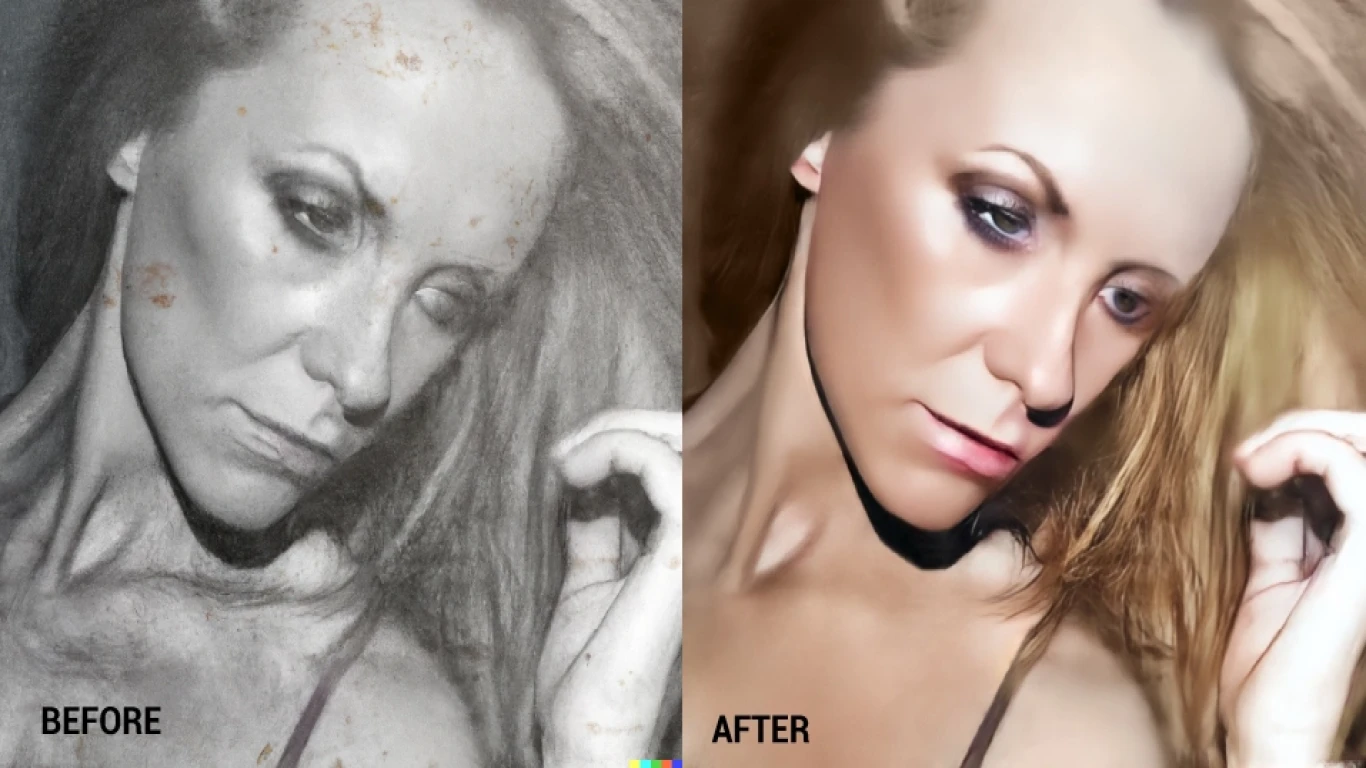What is Photo Restoration? An In-Depth Discussion
by Delwar Hussain / Last Update: September 18, 2023
Welcome to the captivating world of Photo Restoration, where the past is brought back to life through a delicate process of revitalizing and preserving cherished memories. Have you ever gazed upon an old, worn-out photograph and wondered about the stories it holds within its faded hues? Photo restoration is the enchanting art that allows us to peel back the layers of time, unveiling the true essence of those captured moments. Let’s discover what is photo restoration!
Imagine stumbling upon an ancient photo album filled with sepia-toned images that harken back to a bygone era, or uncovering a dusty shoebox tucked away in the attic, concealing a treasure trove of family portraits. These nostalgic relics, once ravaged by the passage of time and the touch of fate, can now be reborn with newfound clarity and vibrancy.
In this in-depth discussion on photo restoration, we shall embark on a journey to understand the intricacies of this art form that defies the boundaries of time. From the careful evaluation of the original photographs to the digital wizardry of modern restoration software, we shall explore the multifaceted process that breathes life into fading memories.
But beware, for within the world of photo restoration lies a captivating duality – a delicate balance between authenticity and artistry. As we venture forth, we shall encounter the ethical considerations that surround the manipulation of historical images, acknowledging the importance of preserving their integrity while unleashing the creative potential of restoration.
In the following sections, we shall unravel the secrets behind restoring black and white photos to their former glory, rescuing images marred by water damage and torn edges, and even reviving vintage gems with their sepia charm intact. Whether you’re a curious enthusiast or an aspiring restoration virtuoso, this article promises to serve as your guide through the wonders and challenges of photo restoration.
So, fasten your seatbelts, and let us delve into the captivating world of photo restoration – a realm where pixels and memories intertwine, and the past finds its place in the present once more.
What Is Photo Restoration Process: Preserving Memories Digitally
Assessment and Evaluation of Original Photographs
In the enchanting realm of photo restoration, every journey begins with a meticulous examination of the original photographs. Like a seasoned detective, the restoration expert carefully scrutinizes the aged prints, seeking clues about their history and the challenges that lie ahead. Each crease, scratch, tear, and faded hue tells a story, and it is through this visual investigation that the path to resurrection begins.
The assessment process is akin to navigating a labyrinth of time. The restoration artist must determine the extent of damage and decay, identifying areas that demand delicate touch-ups and those that require more robust reconstruction. Deciphering the puzzle of a torn family portrait or deciphering the layers of discoloration in a vintage landscape photograph requires both keen eyes and profound technical knowledge.
Digital Scanning and Archiving for Photo Albums
Once the intricate details of the original photographs have been deciphered, it is time to immortalize them in the digital realm. The delicate dance between the analog past and the digital future begins with the process of scanning the physical prints.
Through the magic of advanced scanning technology, these old-world memories are transformed into digital files, paving the way for a new chapter in their preservation. The restoration artist delicately positions each photograph on the scanner, ensuring that no nuance is lost in the transfer.
Choosing the right scanning resolution and format is a critical step in this process. Higher resolutions capture the smallest nuances and details, allowing for more comprehensive restoration possibilities. Meanwhile, selecting the appropriate format ensures that the digital copies retain the highest possible quality and compatibility across various devices and platforms.
Retouching and Color Correction in Photo Restoration
With the digital files at their disposal, the restoration artist embarks on a voyage through time, breathing life into the faded memories. The process of retouching and color correction is where artistry and skill intertwine, as they navigate the delicate balance between restoring authenticity and adding a touch of magic.
The restoration artist employs an arsenal of digital brushes and tools to delicately remove the imperfections that mar the beauty of the photographs. Each stroke is a careful dance of precision, seamlessly erasing scratches, dust, and blemishes, revealing the pristine essence of the images.
Color correction, another facet of this intricate process, breathes vibrancy back into the photographs. The once-faded hues are revived, lending a newfound brilliance to the moments captured within. The artistry lies in striking the perfect balance, staying true to the original palette while enhancing the visual impact of the images.
Amidst this digital alchemy, the restoration artist often encounters color casts and faded eye colors, which require special attention and expertise to recreate the authenticity of the original subjects. This is where the true mastery of the craft comes to light, as the restoration artist meticulously adds brushstrokes of life to once lifeless eyes.
The photo restoration process is a dance of delicacy and ingenuity, where time-traveling pixels meet the hands of an artist, working in harmony to unveil the essence of cherished memories. In the next segment, we shall explore the art of repairing tears and missing elements in damaged photos, a testament to the resilience of both photographs and the memories they hold.
Repairing Tears and Missing Elements in Damaged Photos
As we venture further into the heart of photo restoration, we encounter photographs that have endured the trials of time, their surfaces marred by the ravages of age. Torn and damaged images, once considered beyond repair, find hope in the hands of skilled restoration artists.
The restoration of torn photographs is a delicate dance of both science and art. Armed with digital tools and profound knowledge, the restoration artist begins the process of healing these visual wounds. The torn edges are meticulously mended, and missing fragments are carefully reconstructed, as if breathing life into the fragments of a broken memory.
But it is not only tears that can plague these precious memories. Time’s relentless touch may have erased certain elements from the images altogether. Whether it be a missing face from a cherished family portrait or a scenic backdrop that once defined a moment, the restoration artist defies the boundaries of time to restore what has been lost.
Through a combination of digital manipulation and artistic ingenuity, the artist endeavors to bridge the gaps in the photographs, resurrecting the missing pieces with astonishing precision. Each stroke of the digital brush, like an act of visual archaeology, uncovers the hidden layers of the past, gradually reconstructing the essence of what once was.
The restoration of torn and incomplete photographs is a testament to the dedication and passion of those who engage in this intricate art form. Beyond the pixels and digital tools lies a profound understanding of the value of these images – they are not just photos but guardians of memories, preserving the narratives of our shared humanity.
Restoration of Black and White Photos
Among the myriad challenges that the restoration artist faces, the restoration of black and white photos stands as a unique and captivating endeavor. These monochromatic snapshots of the past, stripped of color yet brimming with emotion, demand a distinct approach to restoration.
Restoring black and white photos involves unlocking the secrets held within the shades of gray, where nuances and contrasts become the canvas for visual storytelling. The artist carefully navigates the intricate tones, breathing life into the images without the vibrant palette that colors offer.
Balancing the highlights and shadows, the restoration artist reveals the intricate textures and details that hide within the monochrome facade. Each brushstroke is a tribute to the artistry of the original photographer, respecting their vision while breathing new life into their captured moments.
For those seeking a bridge between the past and present, the restoration of black and white photos offers a captivating window into history. Through the artist’s skill, these images transcend time, transcending the boundaries of eras and capturing the essence of the human experience.
Restoring Vintage and Sepia Photos
Step into the sepia-toned world of vintage photographs, where memories acquire a timeless charm and nostalgia paints the scenes with warm hues of antiquity. Restoring these vintage treasures is an exquisite endeavor, where the past and present intertwine in an evocative dance.
Preserving the authenticity of vintage photographs requires a careful balance between restoration and conservation. The restoration artist skillfully enhances the faded sepia tones, adding richness and depth to the images without compromising the inherent allure of their antiquity.
This restoration process is akin to a journey through time, as the artist ventures to unearth the stories held within the sepia veneer. The delicacy of the process lies in striking the perfect balance, enhancing the images while preserving the unique qualities that define vintage photography.
In the skilled hands of the restoration artist, vintage and sepia photos transcend the boundaries of time, transporting viewers to eras long gone. These images become portals to the past, where one can glimpse the echoes of forgotten moments and the echoes of the human spirit that endure through generations.
Dealing with Water Damage in Photos
Water, the giver of life, can also be a formidable foe to the delicate world of photographs. The destructive touch of water leaves behind stains, blurs, and distortions that challenge the restoration artist’s skills.
Dealing with water-damaged photos requires both technical expertise and a keen eye for detail. The restoration artist embarks on a quest to reverse the effects of moisture, carefully removing the stains and mitigating the damage that water has wrought.
In this delicate dance with water damage, the restoration artist demonstrates the remarkable resilience of both photographs and the memories they carry. With each digital stroke, the once-tainted images are transformed into vibrant reflections of their former selves.
As the process unfolds, the restoration artist not only revives the images but also preserves their newfound clarity, ensuring that they are safeguarded against future encounters with water’s embrace.
Digital Photo Restoration: Tools and Techniques
Digital Photo Restoration Software
Welcome to the technological marvels that empower the art of digital photo restoration. In this age of digital creativity, a vast array of powerful software programs emerges as invaluable allies to restoration artists. These digital tools, like a painter’s palette, allow for the meticulous retouching, reconstruction, and enhancement of photographs, breathing new life into the fading memories.
Among the software wonders, Adobe Photoshop stands tall as the industry standard for photo restoration. With its diverse range of tools and features, Photoshop opens a world of possibilities for artists to manipulate and restore photographs with precision. From removing blemishes to reconstructing missing elements, Photoshop’s magic lies in its versatility and finesse.
Another renowned contender in the realm of digital restoration is Corel PaintShop Pro. Like a trusted companion, PaintShop Pro offers an arsenal of tools tailored to the specific needs of restoration artists. Its intuitive interface and powerful image processing capabilities allow for seamless touch-ups and color corrections, paving the way for stunning transformations.
Beyond these giants, a plethora of specialized photo restoration software caters to every restoration need. DxO Photolab, for instance, excels in noise reduction and lens correction, while Topaz DeNoise serves as a powerful ally in the battle against digital artifacts.
Importance of Professional Expertise in Photo Restoration Service
While digital software has revolutionized the restoration landscape, it is the skilled hands and keen eyes of the restoration artists that truly bring these photographs back to life. The art of photo restoration goes beyond the mastery of tools; it demands a profound understanding of photography, art, history, and human emotions.
For complex restoration projects and cherished family heirlooms, professional expertise becomes paramount. Restoration artists possess the technical acumen to navigate the intricacies of the software, but more importantly, they wield a deep appreciation for the value these photographs hold in the hearts of individuals and families.
The restoration artist’s journey begins with empathy – to understand the stories embedded in each photograph and the emotions they evoke. They embark on a quest to not merely restore images but to rekindle memories and forge connections to the past.
Engaging a professional photo restoration service offers reassurance that the memories closest to your heart are in the hands of dedicated custodians. Their passion, skill, and artistry ensure that the images cherished by generations remain preserved for the generations to come.
The union of technology and artistry, embodied by restoration artists, stands as a testament to the human spirit’s indomitable desire to honor the past while embracing the possibilities of the digital future.
DIY Photo Restoration: Tips and Software
In the spirit of embracing creativity and the democratization of technology, the world of photo restoration beckons enthusiasts and novices alike. For those with a penchant for hands-on endeavors, a treasure trove of DIY photo restoration tips and software awaits.
Basic Photo Editing Software for Photo Restoration
DIY photo restoration begins with readily available photo editing software that offers an array of tools to restore and enhance images. Adobe Photoshop Elements, for instance, provides a user-friendly interface, making it accessible to beginners while offering essential restoration features.
For those seeking open-source alternatives, GIMP (GNU Image Manipulation Program) emerges as a powerful option. With an active community and a range of plugins, GIMP allows for creative freedom and restoration possibilities.
Repairing Minor Damage in Old Photos
Minor damage to photographs need not be an insurmountable challenge. Armed with basic editing tools, one can do photo healing. Dust and scratches can be easily removed with the clone stamp or healing brush tool, breathing new life into the images.
For those seeking to tackle tears and missing elements, the process may demand more finesse. Gently experimenting with layers and blending modes, and carefully reconstructing missing areas can be a rewarding undertaking for the adventurous DIY restorer.
Preserving and Storing Restored Photos in Digital Format
As the restoration process unfolds, the final products demand preservation to safeguard against the passage of time. Digitally restored photos are treasures to be cherished, and choosing the right file formats and archiving methods ensures their longevity.
JPEG, the ubiquitous format, strikes a balance between file size and quality but may be prone to compression artifacts. For lossless preservation, consider formats like TIFF, which preserve every pixel of the image, ensuring the highest fidelity.
Beyond the technical aspects, preservation extends to the realm of sentimentality. Organizing restored photos into albums, creating digital libraries, or crafting personalized slideshows can add an extra layer of emotional depth to these precious visual narratives.
Ethics of Photo Restoration: Balancing Authenticity and Artistry
As we traverse the enchanting world of photo restoration, we encounter a delicate tightrope walk – a balancing act between authenticity and artistic license. The restoration artist grapples with ethical considerations that arise when retouching historical images.
Authenticity and Manipulation in Photo Restoration
The restoration process raises questions about the degree to which images should be altered. Should every scratch, tear, and blemish be removed, or should some marks be retained to preserve the authenticity of the photograph? Striking this balance is both an art and a moral responsibility.
Restoration artists must tread lightly, respecting the historical integrity of the images while acknowledging the creative potential of the restoration process. The goal is not to erase history but to enhance it, to breathe new life into the images while remaining faithful to the narratives they encapsulate.
Consent and Copyright Issues in Photo Restoration
Beyond the artistic dilemma, the restoration artist must navigate legal and ethical waters concerning the ownership and use of photographs. Obtaining consent from photo owners and respecting copyright laws becomes an integral part of the restoration journey.
Responsible restoration artists collaborate closely with the photo owners, seeking their input and understanding their wishes for the restoration process. Transparent communication ensures that the final result aligns with the collective vision, paying homage to the memories held within the photographs.
Conclusion
I hope this article will help you know what is photo restoration from top to bottom. The captivating world of photo restoration beckons us to embrace the past with renewed vigor and awe. Through the skilled hands of restoration artists and the power of digital technology, faded memories resurface, bridging the gaps between generations and cultural heritage.
In this alchemy of pixels and emotions, we find stories reborn and connections rekindled. Photo restoration is more than the restoration of images; it is the preservation of the human spirit, the celebration of our shared history, and the honoring of cherished memories.
As we partake in this timeless art form, we carry forward the legacy of those who came before us, ensuring that the memories and moments captured in photographs endure for generations yet to come.
Article by
Delwar Hussain
Image Processing Expert, Photography Enthusiast, Blogger, COO at Cutting Edger
Over 18 years of experience in Graphic Design, Image Editing, 3D Modeling/Rendering and Digital Products, I have got opportunity to work with different local and multi-national companies, among of them GraphicPeople, Modern Herbal Group and British Broad Casting (BBC) can be highlighted. During my career I have worked with Coca-Cola, Turkish Airlines, Singapore British American Tobacco, Dell, Pfizer Pharmaceuticals, Indeed.com, International Hotel Group (IHG), Santander Bank, Quad Inc. Adidas, Nike, Dove etc. Having 18 years of experience and being a Co-Founder and COO of Cutting Edger is providing Post Production Image Editing, 3D Modeling and Rendering, Desktop Publishing and Digital Products like Web Design and Development, Software Development, etc.

